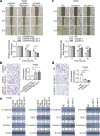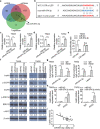Aberrant miR-874-3p/leptin/EGFR/c-Myc signaling contributes to nasopharyngeal carcinoma pathogenesis
- PMID: 35778755
- PMCID: PMC9248092
- DOI: 10.1186/s13046-022-02415-0
Aberrant miR-874-3p/leptin/EGFR/c-Myc signaling contributes to nasopharyngeal carcinoma pathogenesis
Abstract
Background: Leptin is important in physiological and pathological functions in various cancers, however, the significance and mechanisms of leptin in nasopharyngeal carcinoma remain ambiguous.
Methods: Leptin expression was analyzed by QPCR, immunohistochemistry, Western blotting, and TCGA database. The impact of gain- or loss-of-function of leptin were determined by MTT, colony formation, wound healing, and Transwell assays in NPC cells, and by a xenograft tumor model. Leptin-modulated glucose consumption and lactate production were assessed by ELISA. Furthermore, leptin-regulated signaling pathways were examined by QPCR and Western blotting assays. The immunoprecipitation assay was conducted to determine interaction between leptin and EGFR. In addition, miR-874-3p-regulated leptin expression was evaluated using bioinformatics, QPCR, luciferase assay, AGO2-RIP assay, and Western blotting.
Results: In this study, we found that leptin was highly expressed in the sera and tumor tissues of patients with NPC, and elevated leptin expression was associated with advanced clinical features and poor prognosis. Functional assays demonstrated that leptin remarkably promoted NPC cell growth, motility, and glycolysis in vitro and in vivo. Mechanistically, leptin associated with EGFR, resulting in enhanced cell growth through the regulation of cell-cycle related markers, glycolysis-related genes, and EGFR/AKT/c-Myc signaling. Moreover, leptin potentiated the invasive capacity of NPC cells by promoting EMT. We further explored that miR-874-3p influenced leptin-mediated NPC progression. Overexpression of miR-874-3p prevented cell growth, motility, glucose consumption, and lactate production in NPC cells, whereas miR-874-3p inhibition had the opposite effects. AGO-RIP assays confirmed that Argonaute 2 (AGO2), a protein associated with miR-874-3p, regulated leptin expression in NPC cells. The rescue assays indicated that inhibition of leptin suppressed the effects of miR-874-3p inhibitor. In clinical specimens, miR-874-3p was negatively correlated with leptin.
Conclusions: Leptin may serve as a novel prognostic factor and potential therapeutic target for patients with NPC. In addition, a newly discovered regulatory axis of leptin/EGFR/AKT/c-Myc can provide a novel therapeutic strategy for NPC.
Keywords: EGFR; Leptin; NPC.
© 2022. The Author(s).
Conflict of interest statement
The authors declare no conflicts of interest.
Figures









Similar articles
-
VPS33B interacts with NESG1 to modulate EGFR/PI3K/AKT/c-Myc/P53/miR-133a-3p signaling and induce 5-fluorouracil sensitivity in nasopharyngeal carcinoma.Cell Death Dis. 2019 Apr 3;10(4):305. doi: 10.1038/s41419-019-1457-9. Cell Death Dis. 2019. PMID: 30944308 Free PMC article.
-
MicroRNA-199a-3p suppresses the invasion and metastasis of nasopharyngeal carcinoma through SCD1/PTEN/AKT signaling pathway.Cell Signal. 2023 Oct;110:110833. doi: 10.1016/j.cellsig.2023.110833. Epub 2023 Aug 4. Cell Signal. 2023. PMID: 37543098
-
CircZNF609 promotes cell proliferation, migration, invasion, and glycolysis in nasopharyngeal carcinoma through regulating HRAS via miR-338-3p.Mol Cell Biochem. 2021 Jan;476(1):175-186. doi: 10.1007/s11010-020-03894-5. Epub 2020 Sep 24. Mol Cell Biochem. 2021. PMID: 32970285
-
microRNA-342-3p targets FOXQ1 to suppress the aggressive phenotype of nasopharyngeal carcinoma cells.BMC Cancer. 2019 Jan 24;19(1):104. doi: 10.1186/s12885-018-5225-5. BMC Cancer. 2019. PMID: 30678643 Free PMC article.
-
The role and mechanism of aerobic glycolysis in nasopharyngeal carcinoma.PeerJ. 2025 Apr 2;13:e19213. doi: 10.7717/peerj.19213. eCollection 2025. PeerJ. 2025. PMID: 40191756 Free PMC article. Review.
Cited by
-
An integrated analysis of dysregulated SCD1 in human cancers and functional verification of miR-181a-5p/SCD1 axis in esophageal squamous cell carcinoma.Comput Struct Biotechnol J. 2023 Aug 16;21:4030-4043. doi: 10.1016/j.csbj.2023.08.009. eCollection 2023. Comput Struct Biotechnol J. 2023. PMID: 37664175 Free PMC article.
-
Influence of metabolic stress and metformin on synaptic protein profile in SH-SY5Y-derived neurons.Physiol Rep. 2023 Nov;11(22):15852. doi: 10.14814/phy2.15852. Physiol Rep. 2023. PMID: 38010200 Free PMC article.
-
Multi-stage mechanisms of tumor metastasis and therapeutic strategies.Signal Transduct Target Ther. 2024 Oct 11;9(1):270. doi: 10.1038/s41392-024-01955-5. Signal Transduct Target Ther. 2024. PMID: 39389953 Free PMC article. Review.
-
Nucleus-targeted Silencer nanoplatform regulating ZEB1-AS1 in head and neck squamous cell carcinoma therapy.Discov Nano. 2024 Nov 23;19(1):192. doi: 10.1186/s11671-024-04148-9. Discov Nano. 2024. PMID: 39579302 Free PMC article.
-
miRNA-431-5p enriched in EVs derived from IFN-β stimulated MSCs potently inhibited ZIKV through CD95 downregulation.Stem Cell Res Ther. 2024 Nov 19;15(1):435. doi: 10.1186/s13287-024-04040-4. Stem Cell Res Ther. 2024. PMID: 39563434 Free PMC article.
References
MeSH terms
Substances
Grants and funding
LinkOut - more resources
Full Text Sources
Research Materials
Miscellaneous

